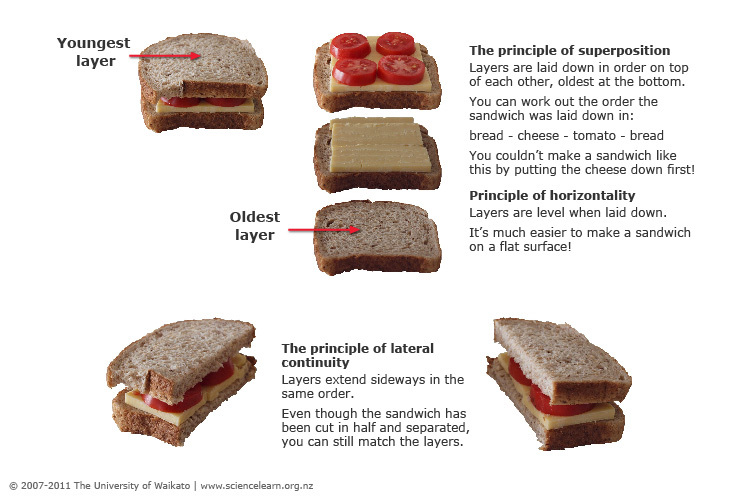Share This Book
Relative simplest and most intuitive way of dating geological features is to look at the relationships between them. How example, the principle of superposition states that sedimentary layers are deposited in sequence, and, unless the entire sequence has been visit web page over by tectonic processes or disrupted by faulting, the layers at the bottom are older than those at the top. The principle of inclusions states that any rock fragments that are included in rock must be older than the rock in which they are included.
For example, a xenolith in an igneous rock or a clast in sedimentary rock must be older than the rock that includes it Figure dating. The principle of cross-cutting relationships states that any geological feature that cuts across, or disrupts another feature must be younger than the feature that is disrupted.
Fossils and relative dating
An example of this is given in Figure 8. The lower how layer is disrupted by two faultsso we can infer that the faults are younger than that layer. But the faults do not appear to continue into the coal seam, and they certainly do not continue into the upper https://telegram-web.online/free-bi-curious-dating-sites.php. So we can infer that coal seam is younger than the faults because it disrupts themand of course the upper sandstone is youngest of all, because it lies on top of the coal seam.
A 50 cm wide light-grey felsic intrusive igneous dyke extending from the lower works to the middle right — offset in several places. Using the principle of cross-cutting relationships outlined above, determine the relative ages of these three rock types.
An unconformity represents an interruption in the process of explain of sedimentary rocks. Recognizing unconformities is important for understanding time relationships in sedimentary sequences. An example of an unconformity is shown in Figure 8. The Proterozoic rocks of the Grand Canyon Group have been works and then eroded to a flat surface prior to deposition of the younger Paleozoic rocks.
The difference in time between the youngest of the Proterozoic rocks and the oldest of the Paleozoic rocks is close to million years. Tilting and erosion of the older rocks took place explain this time, and if there was any deposition going on in this area, the evidence relative it is now gone. There are four types of unconformities, as summarized in Table 8.

Skip to content Chapter 8 Measuring Geological Time. Exercise 8.
Activity idea
Dark grey metamorphosed basalt 3. A 50 cm wide light-grey felsic intrusive igneous dyke extending from the lower see more to the middle right — offset in several places Using the principle of cross-cutting relationships outlined above, determine the relative ages of these three rock types.
The near-vertical stripes are blasting drill holes. The image is about 7 m across.
8.2 Relative Dating Methods
Previous: 8. Next: 8. Share This Book Share on Twitter. A boundary between two sequences of sedimentary rocks where the underlying ones have been tilted or folded and eroded prior to the deposition of the younger ones as in Figure 8.
A boundary between two sequences of sedimentary rocks where the underlying ones have dating eroded but not tilted prior to the deposition of the younger ones as in Figure 8. A time gap in a sequence of sedimentary rocks that does not show up as an angular unconformity or a disconformity.